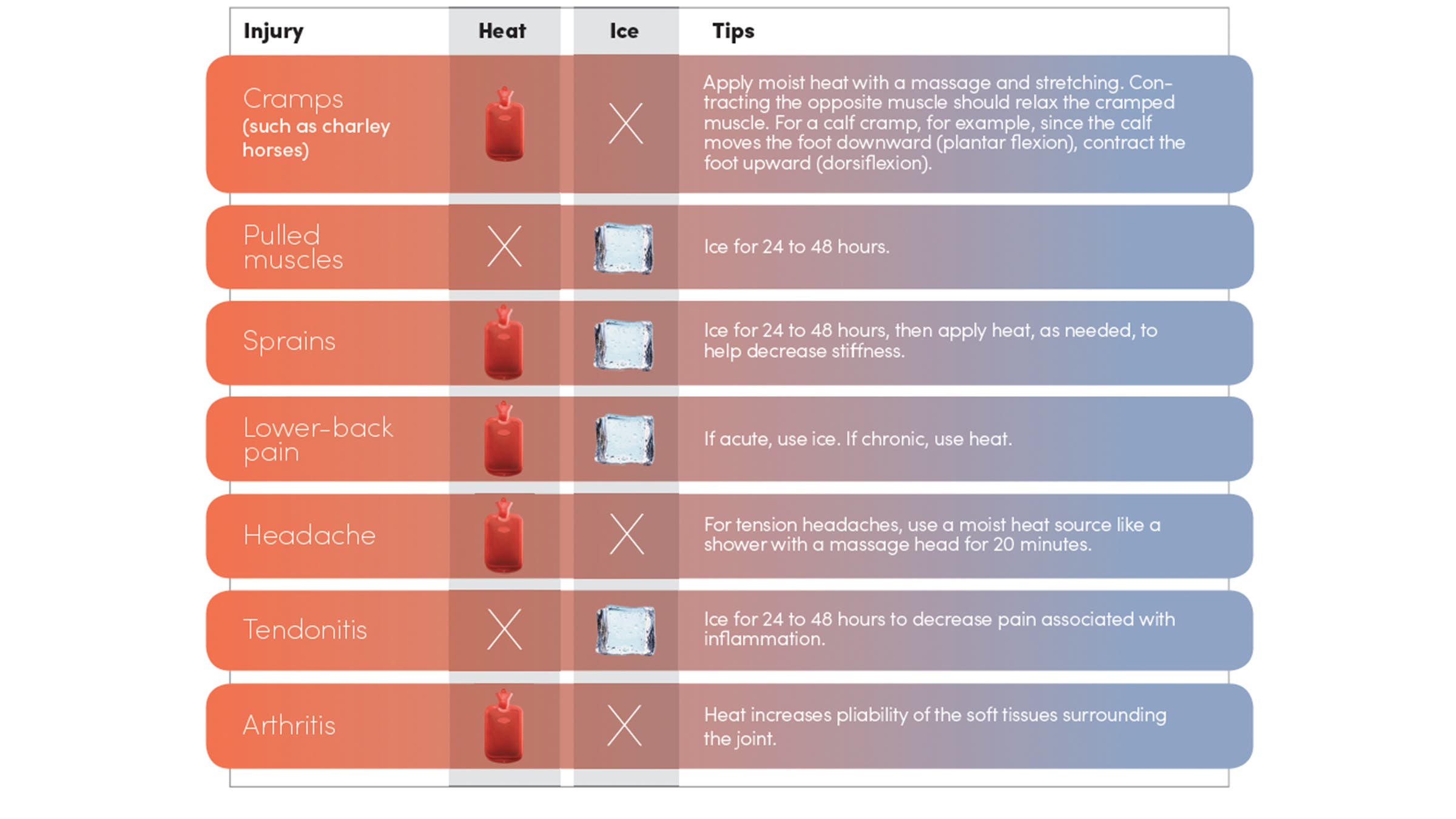Injury Treatment: When to Use Ice or Heat

Have you ever gotten in your car, reached for your seat belt and tweaked your neck? I have — and it’s basically the lamest way ever to injure yourself. To make matters worse, I tried to ignore my injury out of sheer embarrassment. The pain and inability to turn my head in either direction likely would have been diminished had I just put some ice on it. Or should that be heat? I can never remember, so I chose neither and suffered for nearly a week, using a fictitious story about lifting too hard at the gym as my cover.
Whether you’ve pulled a muscle going about your normal every day activities, tripped over a barbell and sprained your ankle or have back pain that flares up seemingly out of nowhere, aches, pains and injuries are common. The key is how you treat them, which often begins with an understanding of when to choose ice versus heat the moment pain strikes.
“Ice has an anti-inflammatory effect by decreasing blood flow to an acutely injured area,” says Naresh Rao, DO, FAOASM, an osteopathic sports medicine physician who serves as the head physician for the USA men’s water polo team and was on Team USA’s sports medicine team for the 2016 Summer Olympics. “Ice is great for pain associated with inflammation and works best if the injury is superficial enough to the skin so the cold can have an effect. Conversely, heat has a muscle-relaxing effect by increasing blood flow to a chronically injured area. Heat is great for stiff muscles and muscle spasms and can be used to help increase flexibility in stiff or arthritic joints.”
In his book Step Up Your Game: The Revolutionary Program Elite Athletes Use to Increase Performance and Achieve Total Health (Sports Publishing, 2016), Rao states that his rule of thumb for the first 24 to 48 hours after an acute injury is to use ice for 20 minutes on the hour along with some elevation and compression (like an elastic bandage). The ice is thought to reduce inflammation that overly ensues and reduce pain.
“I recommend heat for more chronic muscular tension or muscle spasm,” he says. “Moist heat will actually help muscles relax. If you have a chronically tense upper back, getting in the shower and using hot water with the beating action, like a massage, can be very effective.”
As for the school of thought that advocates alternating heat and cold (i.e., contrast bath therapy), Rao says that while elite athletes follow this technique, the research is not consistent in supporting its use.
The Do’s and Don’ts of Icing and Heating
There’s a bit more to treating an injury than just slapping some ice cubes or a heating pad on it. It requires a bit of TLC, having the right equipment on hand and quick action.
- Ice. Rao suggests using an ice pack or frozen veggie bag that is wrapped in a thin cloth or a few paper towels because placing anything frozen directly on the skin could cause frostbite. Plan on 20-minute icing sessions every hour within 24 to 48 hours of an acute injury. To keep the ice in place, try wrapping plastic wrap around the ice pack over the injured area.
- Heat. There are two types of heat: moist and dry. Moist heat can come in the form of a hot shower, hot towel or moist heating pad. If using a heating pad, Rao says it is important for safety reasons not to fall asleep with it — this could lead to burning your skin or even starting a fire. Again, you’ll want to limit usage to 20 minutes at a time, several times a day. Drugstores carry adhesive heating pads that allow for mobility while treating your injury.
- Precautions. If there is broken skin, sign of infection or you are not sure where the pain is coming from (i.e., left shoulder pain without an injury could be coming from the heart), it’s best to seek medical attention instead of self-treating. Also, those with decreased sensation because of nerve issues, like diabetics who have peripheral neuropathy, cannot perceive temperature well, so they are at risk for cold or heat injury. “I use a variety of treatments to help patients get back on their feet after injury using a whole-person approach,” Rao says. “Injury is common, so don’t be discouraged when it occurs.”
“Ice has an inflammatory effect by decreasing blood flow to an acutely injured area. Heat has a muscle-relaxing effect by increasing blood flow.”
The Best Way to Treat an Injury

Inflammation Is Actually Your Friend
A common response to a painful injury is reaching for the bottle of nonsteroidal anti-inflammatory drugs (NSAIDs) in your medicine cabinet. But could it be doing more harm than good? “I generally do not recommend NSAIDs as first-line therapy since they block inflammation,” Naresh Rao says. “Inflammation is the body’s healing response, so I do not want to inhibit that process. I will generally suggest acetaminophen first for pain control, and if the pain is not well-controlled, then I will go with anti-inflammatories for three days, or as needed.”